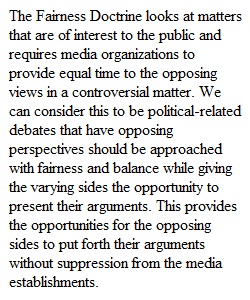


Q Purpose The quality of news content and analysis you receive can vary, depending on which medium (medium is the singular form of media) you are using. This assignment provides two different media sources and requires you evaluate the political information that you were exposed to. Instructions Media bias and consolidation have been under increasing scrutiny in recent years. As a result, many media critics and some politicians have been calling for legislation to help create more political diversity and accuracy in the news. The "Fairness Doctrine" is a proposal that could help with this. Most Americans have probably never heard of it. Have any of you? Step 1: You are required to read a newspaper article and listen to a part of a podcast on the Fairness Doctrine. The article from the Washington Post is here: Fairness Doctrine Download Fairness Doctrine The Ralph Nader Radio Hour podcast is here: Ralph Nader Radio Hour (Links to an external site.) (Links to an external site.)(For the podcast, you only have to. listen up to the 17:20 minute mark. Press the play button at the top of the webpage, as if it were a You Tube video. I know you all know how to do that. ) Step 2: Answer the prompt/question. There are three parts. As always, use proper grammar, punctuation and complete sentences. Part I: Describe what the Fairness Doctrine is (Your textbook has some information on the Fairness Doctrine, but using the article and podcast provide you with enough information on it.) Part II: Which news medium, the article or podcast, do you feel you learned more from? Why? Part III: As a political citizen, what are some advantages and disadvantages of using an article versus a podcast to receive political news from? (To be absolutely clear, I want you to give some advantages and disadvantages for EACH medium.) Replying to classmates is not required for this assignment. If you reply to others, make sure your comments are relevant to this week's topic, the Media, and how we are examining it.
View Related Questions